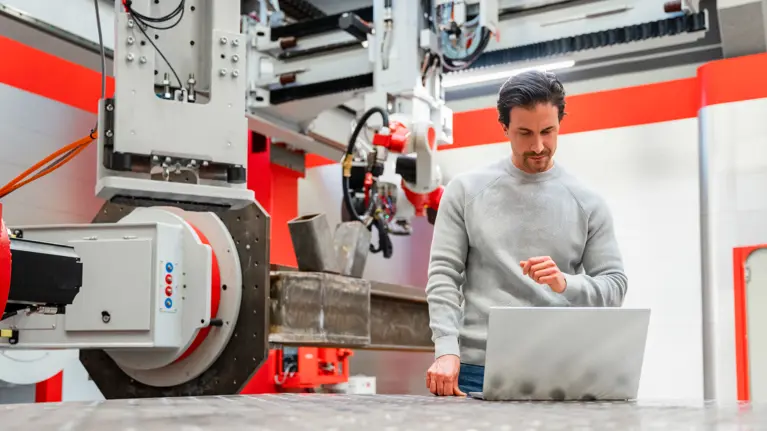
Business servitization: set yourself up for success
Discover the benefits of expanding your traditional product offerings towards a service-centric business model
Staying competitive nowadays takes more than providing excellent products. It’s about delivering ongoing value. Organizations are therefore increasingly turning to business servitization, transforming product sales into service-centric relationships.
As today’s markets evolve faster than ever, businesses can hardly rely on product quality alone. Customers look for ongoing value, flexibility, and solutions that extend beyond one-off sales. This tendency drives a shift toward business servitization where products merge with tailored services. The transition not only strengthens customer relationships but also unlocks revenue increase and long-term growth opportunities. In our blog post, we explore how companies can benefit from servitization, gaining a powerful competitive edge.
Business servitization: bundling products and services
As termed by Vandermerwe and Rada in 1988, servitization of business refers to adding value to core corporate offerings by including services. This approach is led by customer demand and is applicable to a wide range of industries, with manufacturing at the forefront.
Integrating product sales and service provision, however, isn’t characteristic only of the past couple of decades. It’s a phenomenon that can be traced back to the mid-to-late 1800s. But interest in servitization has intensified recently as digital technologies open fresh opportunities to deliver value and unlock revenue streams. In this context, some name it “digital servitization”, or the “transition toward smart product-service-software systems”.
Gartner research found that 38% of the surveyed manufacturing companies already offer digital services to their customers. They expect their revenue from digital services to grow to 29% of the total revenue in 2030, up from 10.4% in 2023.
In terms of Everything-as-a-Service (XaaS), a model where anything can be a service, a report by Spherical Insights & Consulting estimates that the global XaaS market will surge from USD 245.3 billion in 2021 to USD 1,225.1 billion by 2030.
The strategic shift towards a service-centric model is a large-scale initiative that will redefine your business, but there are solid reasons why you should embark on this extensive journey. Let’s examine together some of the key benefits of servitization for your organization.
Benefits of business servitization for your business
In a servitized model, you provide your customers with the outcomes of an offered service. Such an approach is advantageous for your business in different ways.
Steady revenue stream
By replacing one-time product sales with a recurring income from service contracts, subscriptions, or models based on usage, you can more easily forecast your revenue over time. Scientific research also suggests that servitization can lead to an increase in revenue.
Stronger customer relationships
When delivering comprehensive services to your customers, you create long-term relationships that go beyond one-off transactions. You have the tools to personalize your offerings and provide outstanding support, thus improving the customer experience and building loyalty.
Sustainable competitive advantage
A servitized model helps you distinguish your business from your competitors that are focused on product sales and compete on price or features alone. The customized solutions you offer strengthen your brand positioning and let you carve out a niche in the market.
Environmental responsibility
Embracing servitization makes it easier for your organization to adopt circular economy practices, reducing waste and resource use. You can more easily achieve your corporate sustainability goals and position yourself as an environmentally responsible company.
Business servitization advantages for your customers
The service-centric approach brings benefits not only to your business but also to your customers, which is yet another reason to consider going on the servitization journey –satisfied customers drive business success.
Tailored, premium solutions
In contrast to purchasing equipment with pre-defined features and characteristics, your customers receive solutions that are customized to their needs. Besides, they get access to higher-quality products with a better performance.
Shift from CapEx to OpEx
With servitization, customers pay for utilizing a product without purchasing it. Thus, they move from a capital expenses (CapEx) to an operating expenses (OpEx) model, without needing to make large initial investments.
Greater flexibility
When customers don’t fully own the equipment, they have the freedom to use it only temporarily (only when needed). Service contracts allow for flexibility according to operational needs.
Peace of mind
While ownership requires customers to take care of maintenance and repair on their own, service relationships don’t burden them with management of the equipment. These aspects are the responsibility of the service provider.
Business servitization success story
To illustrate how a servitized approach provides advantages both for businesses and their customers, we’ll use the case of a manufacturer we partner with.
A top tier tire company sought to increase their part in their customers’ value-chain by leveraging the power of IoT and data, thus providing solutions beyond pure tire sales. They started developing tires equipped with a variety of sensors to measure tire attributes like pressure, temperature, velocity, and thread depth in working conditions.
The aggregated sensor data created a foundation for the deployment of solutions such as:
- Predictive maintenance support: detecting tire failures before they happen
- Track & trace functionalities: cargo monitoring, geofencing, fast driver support in scenarios requiring urgent tire service
- Tire monitoring: keeping tire pressure recommendations, resulting in significant fuel savings, reduced CO2 emissions, and extending tire lifespan
- Real-time all-wheel status monitoring for drivers.
As their technology partner in this initiative, we deployed and integrated the needed hardware and software components to collect and connect all necessary vehicle data. Once gathered in a transmission control unit (TCU) mounted on the vehicle, the data is delivered to a secure cloud data platform where it can be used for realizing business logic or for data engineering purposes.
A variety of solutions are deployed on top of the platform, such as web and mobile applications for fleet managers, drivers, technicians working in the field, internal R&D, and customer service networks. The platform provides different functionalities: dashboards, reports, alerting (with included predictive components), locating vehicles on the map, etc. There are even data APIs that can be further used in completely new business scenarios (like Tire-as-a-service business models, etc.).
The additional connectivity capability and location data supplied by the sensors enabled the company to achieve their goal – to support fleets by reducing tire-related downtime and maintenance, while maximizing driver safety and tire lifetime.
Conclusion
Business servitization is a smart strategic move for businesses that want to remain competitive. By combining products with tailored services, organizations can secure recurring revenue, deepen customer loyalty, and strengthen their market positioning. At the same time, customers benefit from flexible, outcome-focused solutions that reduce risk and investment burden.
If you’re planning to steer your business in a servitized direction, bear in mind that each organization has its own starting point on this journey. Some start “from scratch”, while others may already be offering more advanced services. Nevertheless, regardless of the maturity level, all paths can lead to an equally successful full-scale transformation if carried out wisely.
Contact us to talk in detail how your business can turn servitization to a great advantage!

Stefan names himself as “Implementation-driven Business Consultant”, supporting his customers in finding the sweet spots between their business goals and technological capabilities. With extensive experience in the manufacturing industry and deep technological expertise, he understands the precise steps required to achieve optimal solutions.



